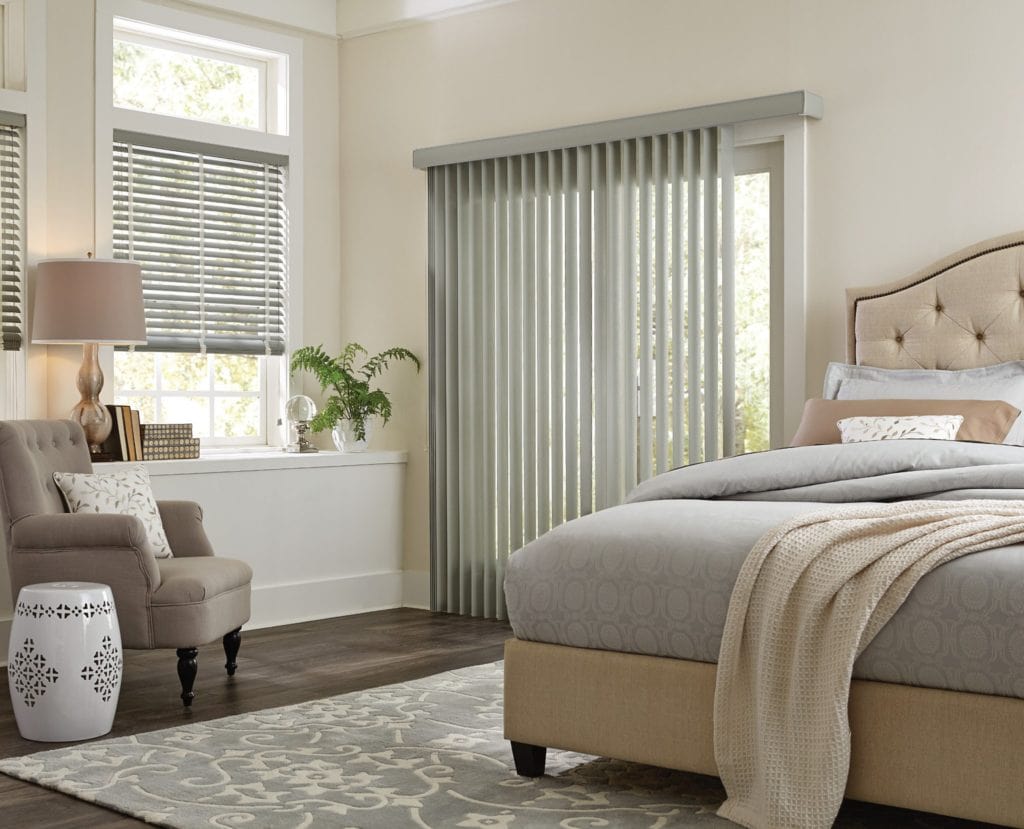
Vertical vs. Horizontal Blinds
Are you stuck between horizontal and vertical blinds for windows? The decision isn’t always straightforward, so taking some time to weigh your options is a good idea. Both types of blinds have distinct advantages, but it’s essential to choose the better option for the specific use case.
We’ll discuss both types of blinds, covering all the important talking points you need to know before deciding.
Vertical Blinds
Vertical blinds feature slats that run up and down, making controlling the unit a lot easier. A slight tug at the pulley system is enough to close or open the slats. The blinds can provide a clear view of the outdoors through one side of the window as the slats stack sideways. Rooms with vertical blinds feel more spacious.
Some of the popular types of vertical blinds for windows include:
- Fabric vertical blinds
- Woven wood vertical blinds
- Vinyl vertical blinds
Where and When to Use Vertical Blinds
Vertical blinds are a perfect match for broad windows. If the window is too big to cover with other window treatments, you can count on vertical blinds to fit effortlessly. Also, since the slats stack sideways, you don’t have to worry about pulling any heavy window treatments up and down. You can use vertical blinds for:
- Wide house windows (> 40 inches wide)
- Sliding glass doors
- Bay windows
- Patio doors
- Sunroom windows and doors
- French doors
- Windows in commercial buildings
Keep in mind that vertical blinds for windows don’t block light completely, so you should avoid using them in any room you’d like to keep dark the majority of the time.
Horizontal Blinds
Horizontal blinds are arguably the more versatile type of window treatment. They fit nicely almost everywhere, regardless of the broader interior décor theme.
The slats run from left to right, allowing you better control over the natural light in any room.
With the slats closed completely, the blinds can block out up to 95% of light. Directing the slats up or down allows you to enjoy your privacy while allowing some light inside the room. In your bedroom, you can turn the slats up at the ceiling to allow the morning light to filter in without getting it directly into your eyes. In the kitchen or your study area, you can direct the slats down toward your work table to keep the sun from getting into your eyes.
The open and close mechanism on horizontal blinds is a bit faster than what you’ll find on vertical blinds. However, controlling the mechanism gets trickier for larger windows, especially with wooden or aluminum blinds. As the blind gets heavier, opening and closing the windows will become more of a chore—unless you install a remote-controlled unit.
Where and When to Use Horizontal Blinds
Horizontal blinds are the perfect match for tall and thin windows. However, many people use them on all kinds of windows, including those in the following:
- Living room
- Kitchen
- Bathroom
- Study area
- Office space
- Bedroom
Horizontal blinds don’t work well for doors because it’s more challenging to get them out of the way. If you add standard horizontal blinds to your doors, you’ll have to leave them rolled up half the time if the area gets a consistent amount of traffic. Otherwise, people will have to push past or roll the blinds up and down frequently—shortening the blinds’ lifespan.
It’s best to consider other types of treatments for your door or request custom horizontal blinds made for doors.
You should also stick with aluminum or faux wood blinds for rooms with high moisture or excessive heat (such as your bathroom or the conservatory). Wood blinds will warp, while fabric blinds will fade a lot faster with constant exposure to the elements.
Get Expert Help from the Window Treatment Professionals
Made in The Shade Blinds & More Raleigh provides expert guidance for our customers stuck between horizontal and vertical blinds for windows.
We offer a free consultation session where we’ll get a good look at the windows, you’re considering outfitting with blinds, and recommend the perfect option for you. Call us today to speak with a member of our team or book an appointment online.














